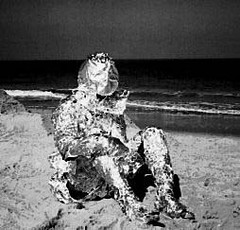and the Palm Beach County “Social Disease.” – Part II
Continued from December 17, 2006Second, I looked for an artist whose work might illustrate, or at least demonstrate some of the same concerns as the feminist,
Judith Butler. I found
Oh Charley, Charley, Charley! by
Charles Ray.
Oh Charley, Charley, Charley! is about the limitations placed on the individual and artist by normative cultural presuppositions and the visual statements artists make about such standardized cultural limits. Ray, however, does not intend to place his work in opposition to these limits. Rather, he wishes to make them apparent.
Oh Charley, Charley, Charley! causes conflict to either a male heterosexist or homosexist position because it appears to be about orgiastic homosexual sex. Let me explain. First, the object appears to be the quintessential demonstration of male, homoerotic sex because there are eight intertwined nude male figures in the sculpture. As such, it is foreign and frightening to the male heterosexist, calling forth nightmares about power and violation. The male heterosexist’s distress is understandable, though limiting since it is founded upon the irrational fear that it is possible to be converted to a gay persuasion, in this case through rape. If that were so, why do most gay persons not fear the opposite? Despite the fact that our culture teaches GLBT persons to believe conversion to a heterosexual persuasion is desirable, by the time most are into their mid-twenties, their non-heterosexual identity is an accepted part of their person. In fact, this resolution of personal conflict has been identified as one of the stages of a non-heterosexual person’s adjustment to his or her sexuality in many coming out models. Kenneth M. Cohen and Rich C. Savin-Williams discuss many such models in “Coming Out,” in
The Lives of Lesbians, Gays, and Bisexuals. *1
The figures in this sculpture, however, are all self-portraits of Charles Ray, and Ray is a heterosexual male. Ray’s heterosexual identity denies the portrayal of desire and sex among these various selves, unless we conceive of the sculpture as a pre-oedipal representation of narcissism. If so, Ray would have been better off with one figure, and nine mirrors. Thus, Ray’s actual intent denies the homosexual fantasy the multiple image seems to indicate.
A closer look at
Oh, Charley, Charley, Charley! will serve to clarify just how disturbing the work is to either heterosexist or homosexist position. The polychrome figures are a smooth even flesh tone. They are about to engage in sexual intercourse, both anal and oral, active and passive. Physical action, however, like in a Poussin painting, is frozen, as though a cold wind has pierced the space the sculpture occupies. The figures are locked in the moment, just before insertion, an encomium to fictitious sexual acts that will not take place.
Most importantly, however, Ray denies that the sculpture is about sexuality at all. Instead, he maintains that it is about a Formalist schema artists use to achieve unity within a composition through the repetition of form or shape. The work is thus engaged in a kind of static dance, both literally and figuratively. The figures are frozen in time and space, disconnected links, like a series of individual motion picture frames with no connection or motion. The figures resist interpretation, even as they twist and turn in suspended animation upon the floor, and they are about sexuality even as they deny it.
Oh, Charley, Charley, Charley! points toward the possibility that beneath our conceptualization of sexuality there lies neither heterosexual identity nor homosexual identity, but something else beyond that dichotomy. After all, Ray himself, as stated above, plays with the likelihood that the viewer will misunderstand his intent. The misinterpretation of artistic intent is in turn based upon a faulty apprehension of “normal behavior.” Ray leads us upon a zany obsessive-compulsive chase. Like a cat in its game of mistaken identity, he is chasing his own tail while we watch and wonder. Does he know what he is doing? His seeming obsessive-compulsive narcissism obfuscates the normative sexual concerns we, as viewers, bring to his sculpture.
Unfortunately, as Palm Beach County government “gay entrapment practice” demonstrates, our culture has neither the time nor the ability to work toward an understanding of it’s own obsessive-compulsive narcissism, and would rather place fear of conversion on gay and straight men on whom nature has called to empty their bladder.
--------------------------
*1 “Coming out” is the process by which a non-heterosexual person accepts his or her sexuality and discloses it to others, family, friends, and co-workers. Some of the models Cohen and Savin-Williams discuss are the following. Hooker, Evelyn A. “Male homosexuals and their worlds,” in J. Marmor, ed. Sexual Inversion: The Multiple Roots of Homosexuality. New York: Basic Books,1965, pages 83-107. Plummer, K. Sexual Stigma: An Interactionist Account. Boston: Routledge, 1975. Myrick, F. L. Homosexual Types: An Empirical Investigation, The Journal of Sex Research. 10: 1974 , 226-237. Elliot, P. E. “Lesbian Identity and Self Disclosure,” Dissertation Abstracts International. 42: 1982, 3494B . Fitzpatrick, G. “Self Disclosure of Lesbianism as related to self-actualization and self-stigmatization,” Dissertation Abstracts International. 43: 1983, 4143B. Hencken, J. D. “Sexual-Orientation Self-Disclosure,” Dissertation Abstracts International. 45:1985, 2310B. (Cohen and Savin-Williams, 117).
You can send E-mail comments to ZacSfuts@Comcast.net
, or post them below.











